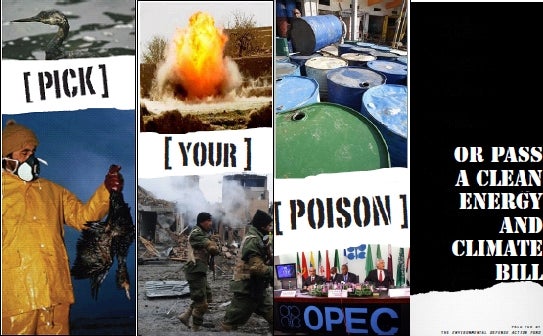1. The American Power Act will help us research and develop innovative renewable energy sources here in America.
- The bill will unleash billions of dollars of private-sector investment in clean energy jobs and projects here in America. Jeff Immelt, Chairman and CEO of General Electric puts it best: “National policy – including an effective price on carbon and a strong, nationwide clean energy standard – is needed to drive increased investment, which in turn creates new technologies and jobs.”
2. The American Power Act was crafted with the intention of rising above partisan politics. This bill is not about choosing sides or playing favorites, is it about finding real solutions to our climate and energy problems and laying the foundation for an international climate treaty.
- Darren Samuelsohn, a top climate and energy reporter, reiterates why a US vote is necessary to get international talks flowing in his aptly titled article “World waiting for U.S. Congress to Pass Climate Bill”
3. The American Power Act will help America become the world leader in clean energy investment and technology, a title currently held by China.
- According to Information Technology and Innovation Foundation “Asia’s rising “clean technology tigers” – China, Japan, and South Korea – have already passed the United States in the production of virtually all clean energy technologies, and over the next five years, the governments of these nations will out-invest the United States three-to-one in these sectors.”
4. The American Power Act is good for American manufacturers. The balanced energy strategy that includes development of alternative energy such as wind and solar as well as investment in new domestic energy sources will create jobs in clean technology manufacturing.
- The bill includes a $5 billion expansion of the clean energy manufacturing tax credit.
5. The America Power Act will create jobs, at least twice as many as an energy-only bill.
- According to Senator Bingaman’s office, an energy-only bill without a cap on carbon would only create 425,000 new jobs. The Department of Economics and Political Economy Research Institute estimated that a climate and clean energy bill will create at least three times that many.
6. The American Power Act will cut carbon pollution 17% by 2020 and 80% by 2050.
- These targets, on par with those in the House bill, will set us on the path toward reversing the damaging environmental effects of climate change.
7. The American Power Act will cut our dependence on foreign oil and help us break the cycle of sending a billion dollars a day to countries that hate us.
- Included in the bill are significant tax incentives for conversion of trucks to natural gas vehicles.
- There is $7 billion annually earmarked for improving transportation efficiencies and mass transit systems.
8. The American Power Act is good for business. It will create predictability in the market, spurring clean energy investment and job creation.
- The APA sets a hard price collar of $12 to $25 for carbon. The tight $13 range is a vast improvement over the $18 range suggested in the House bill. A smaller range limits wild price fluctuations and leads to higher investor confidence levels.
9. The American Power Act will protect Americans, especially low-income Americans, by ensuring that energy costs stay under control and that revenues collected from utilities under a carbon cap will be rebated to consumers.
- In fact, over 82% of the allowance value will be rebated to consumers or used for public services.
10. The American Power Act will help domestic agriculture and forestry by providing farmers, ranchers and forest owners with opportunities for new revenue streams in the off-set market.
- USDA will have authority over the domestic offset program which will ensure wide-spread participation and that benefits are shared across the industry.










